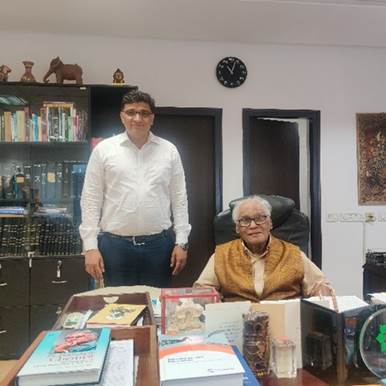A study by Bharat Ratna Professor C N R Rao and his team has explored precise atomic rearrangements that occur in each phase transition of lead iodide perovskites due to altered temperature and pressure and their resulting effects on optoelectronic properties. Such studies could help in efficient renewable energy generation.
In recent years, lead iodide perovskites have attracted much attention, thanks to their astonishingly good optoelectrical properties which make them excellent solar cell materials. While their energy conversion efficiency can be higher than even that of commercial silicon-based solar cells, lead iodide perovskites are not inherently stable materials. Studies have reported that these materials undergo different structural changes (or ‘phase transitions’) even under similar conditions. Temperature and pressure shifts can easily modify their crystalline structure, altering their physical properties and lowering their performance.
An in-depth analysis of their reported phase transitions was therefore essential to understand the current limitations of these materials and get on track toward potential solutions.
In a new study, Professor Pratap Vishnoi and Professor C. N. R. Rao from Jawaharlal Nehru Centre for Advanced Scientific Research (JNCASR) Bengaluru, an autonomous institution under the Department of Science & Technology, Govt. of India have reviewed the current knowledge gaps and recent progress on hybrid lead iodide perovskites. The study was published in the Royal Society of Chemistry’s Journal of Materials Chemistry A and was supported by a Ramanujan Fellowship by the erstwhile Science & Engineering Research Board (SERB) now ANRF of the Govt. of India.
Prof. Vishnoi and Prof. Rao reviewed over a hundred publications of existing literature on the reported phase transitions and crystal structures. They focused on the results of these studies and the experimental methodologies used by their authors. This approach highlighted the strengths and limitations of the commonly employed techniques, such as X-ray and neutron diffraction. The researchers also touched on the topic of chemical instability in lead iodide perovskites, specifically, how and why these materials decompose when exposed to humid air.
One of the main motivations for undertaking this comprehensive review was the huge potential of these hybrid perovskites for commercial applications, primarily due to their varied and unique crystalline structures. The researchers wanted to know the precise atomic rearrangements that occur in each phase transition and how these changes could lead to degraded stability in solar cells and other practical applications.
Notably, the phase transitions induced by temperature and pressure can be quite different in these materials. Thus, two separate main sections were dedicated to exploring the nature of these transitions as sources of instability, highlighting their underlying mechanisms, and their resulting effects on optoelectronic properties.
Further studies on lead iodide perovskites, as well as other types of hybrid perovskites, will hopefully lead to more efficient renewable energy generation. If their instability problems can be efficiently addressed, they could make for great materials for solar cells, since they can be processed into thin films. Other notable use cases are colour LEDs and X-ray shielding in research and medical facilities.

Researchers conduct a comprehensive review to understand the possible phase transitions of iodide perovskites
Image credit: Journal of Materials Chemistry A

Prof. Vishnoi and Prof. CNR Rao
Moreover, they may be a clever way to take advantage of phase transitions to store and transport energy. When certain phase transitions occur, some of the energy accumulated in the previous configuration is released as heat. This could be useful for developing thermal energy storage systems, contributing to sustainable energy solutions.
Excited about the possible future in this field, Prof. Vishnoi concludes by saying, “Our perspective is expected to raise the current level of understanding of structures at the atomic level and provide some new strategies to further design and synthesize stable iodide perovskites.”

Comments are closed.